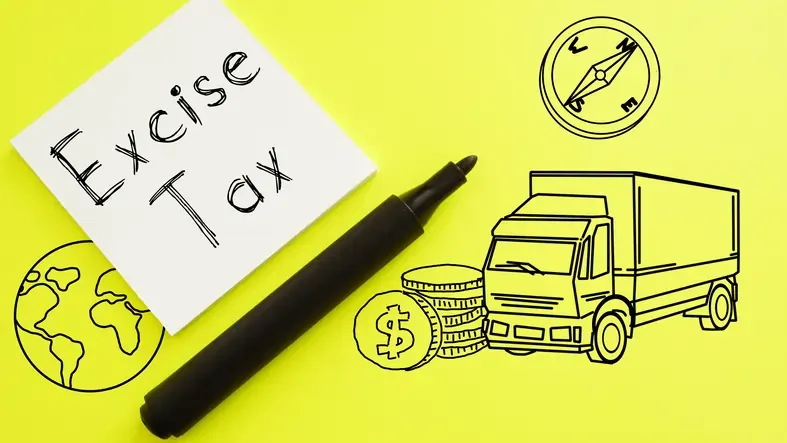
Navigating the complexities of excise taxes is a critical aspect for US residents doing business internationally. This guide is designed to demystify the process of filing excise tax returns and ensure compliance with US tax regulations.
Whether you’re a seasoned entrepreneur or new to the global marketplace, understanding your tax obligations is key to a successful international business.
Excise tax understanding
Excise taxes are indirect taxes levied on the sale or use of certain goods and services. Unlike direct taxes, such as income taxes, which are paid directly by the consumer, excise taxes are often included in the price of the product or service.
These taxes are imposed by the government on specific items, activities, and services, making them an integral part of the total cost.
Excise taxes relevant to US companies abroad
For US companies doing business abroad, excise taxes may apply to a wide range of goods and services. Common examples include alcohol, tobacco products, fuel, and certain luxury items.
In addition, services such as air transportation and activities involving the use of natural resources may also be subject to excise taxes.
It’s important to note that the specific excise taxes applicable to your business will depend on the nature of your business and the countries in which you operate.
Who must file Form 720?
Filing Form 720, Quarterly Federal Excise Tax Return is a requirement for businesses engaged in the sale or manufacture of goods and services subject to federal excise taxes in the United States.
In addition, businesses that provide services such as air transportation or receive payments for certain health and pension plans may also be required to file.
For US residents doing business internationally, the requirement to file Form 720 extends to any business activity that would be subject to excise taxes if conducted within the United States. This includes the need for tax preparation abroad.
This means that even if your company is based or operates outside the US, you may still have obligations under US tax law if your products or services are sold to US customers or if your business activities have a significant nexus with the US.
Exceptions and exemptions
While the scope of Form 720 is broad, there are notable exceptions and exemptions that may relieve companies of the need to file. For example:
- Small businesses that fall below a certain threshold of excise tax liability may be exempt from filing.
- Certain products or services exported from the US may qualify for an excise tax exemption that reduces or eliminates the filing requirement.
- Nonprofit organizations and governmental entities may be exempt from certain excise taxes, depending on the nature of their activities and the goods or services they provide.
It’s important for US residents doing business overseas to carefully review the IRS guidelines on excise taxes and Form 720 to determine their filing obligations. Consulting with a tax professional who understands international business and US tax laws can also provide valuable guidance and ensure compliance.
Preparing to file Form 720
Filing Form 720 requires careful preparation and attention to detail. For US residents with foreign operations, the process involves understanding the specific excise taxes applicable to their business activities and gathering the necessary documentation to ensure accurate reporting.
Collect necessary documents
Before you begin completing Form 720, it’s important to gather all relevant documents and records related to your excise tax liability. These documents typically include
- Sales records. Detailed records of all transactions subject to excise tax during the reporting period. This should include the dates, amounts, and types of goods or services sold.
- Excise tax payment receipts. If you’ve made any excise tax payments during the quarter, make sure you have receipts or bank statements to verify these payments.
- Inventory records. For businesses that deal in physical goods subject to excise taxes (such as alcohol, tobacco, or fuel), accurate inventory records are critical to determining the tax owed.
- Import/export documentation. If your business involves importing or exporting goods, you’ll need documentation that outlines the nature of these transactions, especially if they qualify for excise tax exemptions or rebates.
- Previous excise tax returns. Having your previous Form 720 filings on hand can help ensure consistency and accuracy in reporting from one quarter to the next.
Organizing these documents ahead of time will streamline the filing process and help prevent errors or omissions that could lead to penalties.
Understanding of Form 720
Form 720 is divided into several sections, each designed to capture different types of excise tax liabilities. Familiarizing yourself with these sections before you begin filling out the form can greatly simplify the filing process:
- Part I. Focuses on taxes related to specific goods, environmental taxes, and political taxes. Here you’ll report taxes on fuel, air travel, and health insurance, among others.
- Part II. Covers taxes on various goods and services not included in Part I, such as indoor tanning services and certain fishing equipment.
- Schedules. Schedules provide detailed reporting of specific tax liabilities and credits. For example, Schedule A is used for wagering taxes, while Schedule T covers taxes on motor vehicles.
- Payment Voucher (Form 720-V). If you’re making a payment with your return, you’ll need to complete and attach this voucher.
Form 720 filing process
1.Calculate your excise tax liability
The first step in preparing your Form 720 is to calculate your company’s total excise tax liability. This includes:
- Identifying taxable transactions. Review your sales records to identify transactions that are subject to excise tax. This includes sales of certain goods, such as alcohol, tobacco, and fuel, as well as services, such as air transportation.
- Apply the correct tax rates. Each type of good or service has a specific excise tax rate assigned by the IRS. Apply these rates to the taxable transactions identified in the first step.
- Record payments and credits. If you’ve made any excise tax payments during the quarter or are eligible for credits (such as for fuel sold but not used on highways), subtract those amounts from your total liability.
Accurate calculation is critical to avoiding underpayment or overpayment of taxes. Using accounting software or consulting with a tax professional can help ensure accuracy.
2.Complete and file Form 720
Once you’ve calculated your excise tax liability, the next step is to complete and file Form 720:
- Enter your business information and tax liability in the appropriate sections of the Form 720. Be sure to complete each section that applies to your business and review the form for accuracy.
- Form 720 must be signed by an authorized person, such as the business owner or an authorized agent.
- Form 720 can be filed either by mail or electronically. If you mail the form, make sure it’s addressed to the correct IRS office and include any payment, if due.
Electronic submission options
The IRS encourages electronic filing of Form 720 for several reasons:
E-filing is faster and more convenient than paper filing, allowing for quicker processing of your return.
Electronic filing reduces the risk of error because the e-filing system can catch common mistakes.
You’ll receive immediate confirmation that the IRS has received your form.
To e-file Form 720, you can use the IRS e-file system, which is available through tax preparation software, or a tax professional who offers e-filing services. If you’re new to e-filing, the IRS website has resources and guides to help you get started.
After filing your excise tax return
Once you file Form 720, your responsibilities don’t end there. Ensuring accuracy, maintaining records, and understanding how to address potential issues are critical steps in the post-filing process.
Dealing with errors and changes
Mistakes can happen, and the IRS provides mechanisms for correcting errors on filed excise tax returns:
- Periodically review your filed returns and supporting documentation. If you discover an error, assess its impact on your tax liability.
- To correct errors on a previously filed Form 720, you’ll need to file an amended return. This involves completing a new Form 720 for the same period, clearly indicating that it’s an amendment, and detailing the corrections made.
- If you’re not sure how to correct an error or if the amendment process seems complex, consulting with a tax professional can provide clarity and ensure that your amended return complies with IRS requirements.
Records and compliance
Keeping comprehensive records is essential not only for accurate tax filing but also for compliance with IRS regulations:
- Keep all documents related to your excise tax liability, including sales records, tax payment receipts, and any correspondence with the IRS. These should be kept for at least three years from the date you filed your return.
- Develop a system for organizing your records so that they can be easily retrieved. This can be especially important if the IRS requests documentation to support your filed returns.
- Stay informed about changes in tax laws and regulations that may affect your excise tax obligations. Regularly review IRS publications or consult with a tax advisor to ensure ongoing compliance.
Bottom line
Filing Form 720 is a critical obligation for US residents doing business abroad, requiring careful preparation, accurate calculation of tax liability, and compliance with filing deadlines. However, your responsibilities extend beyond filing the form.
Addressing any errors, maintaining comprehensive records, and ensuring ongoing compliance with tax laws are essential practices that protect your company’s financial health and legal standing.
By taking these responsibilities seriously and seeking professional guidance when necessary, you can navigate the complexities of excise tax reporting with confidence and ensure your business thrives in the global marketplace.


